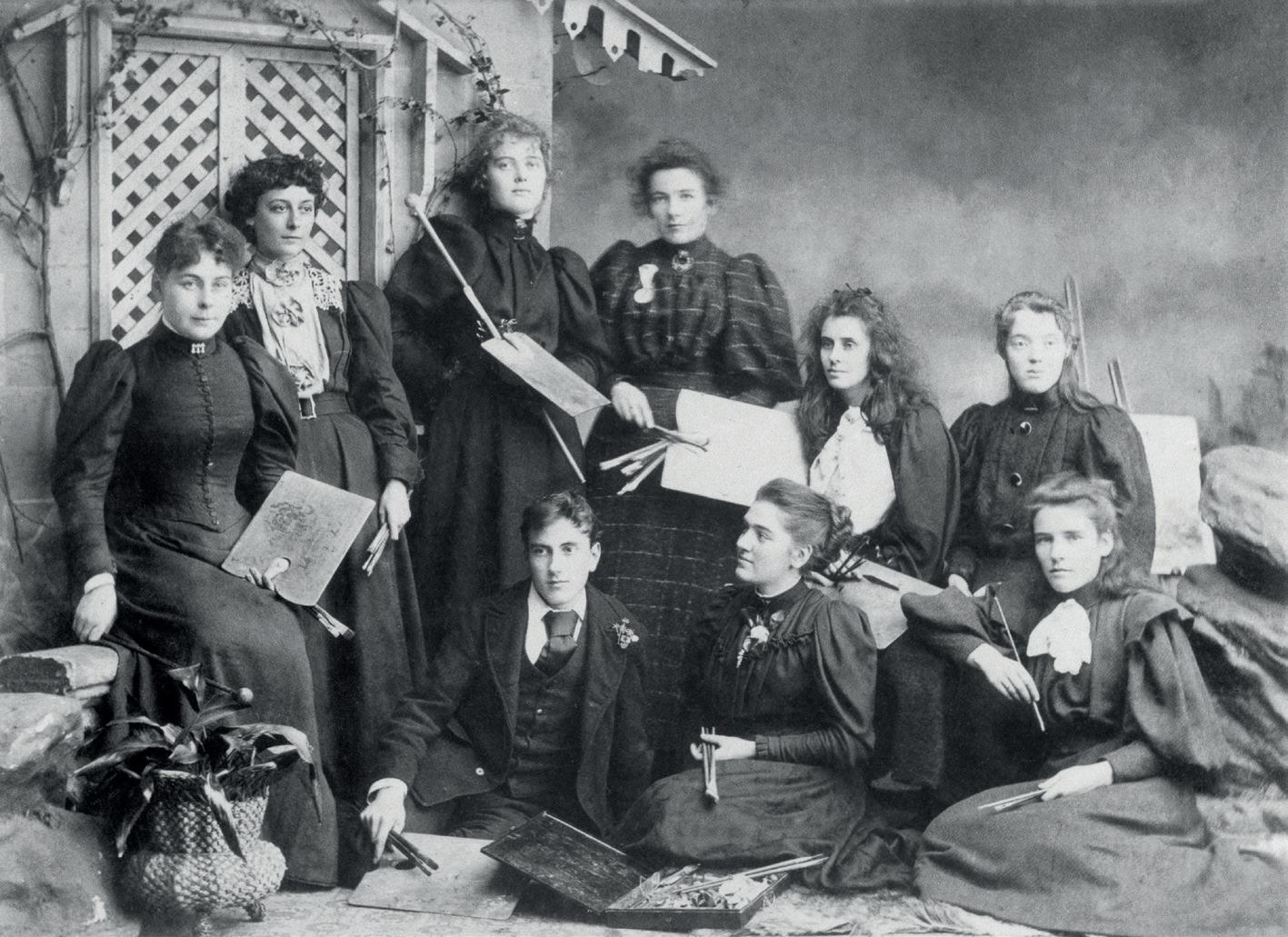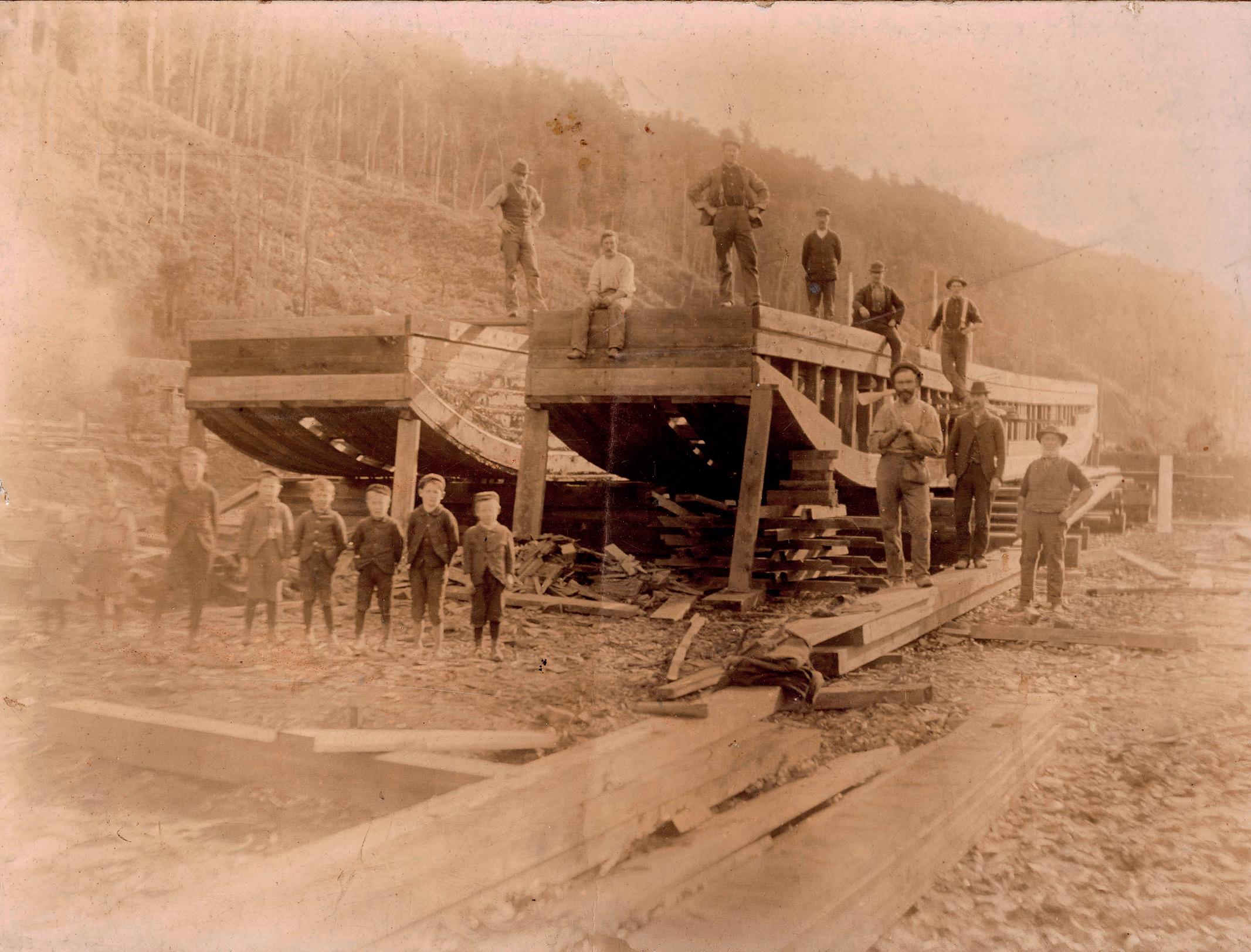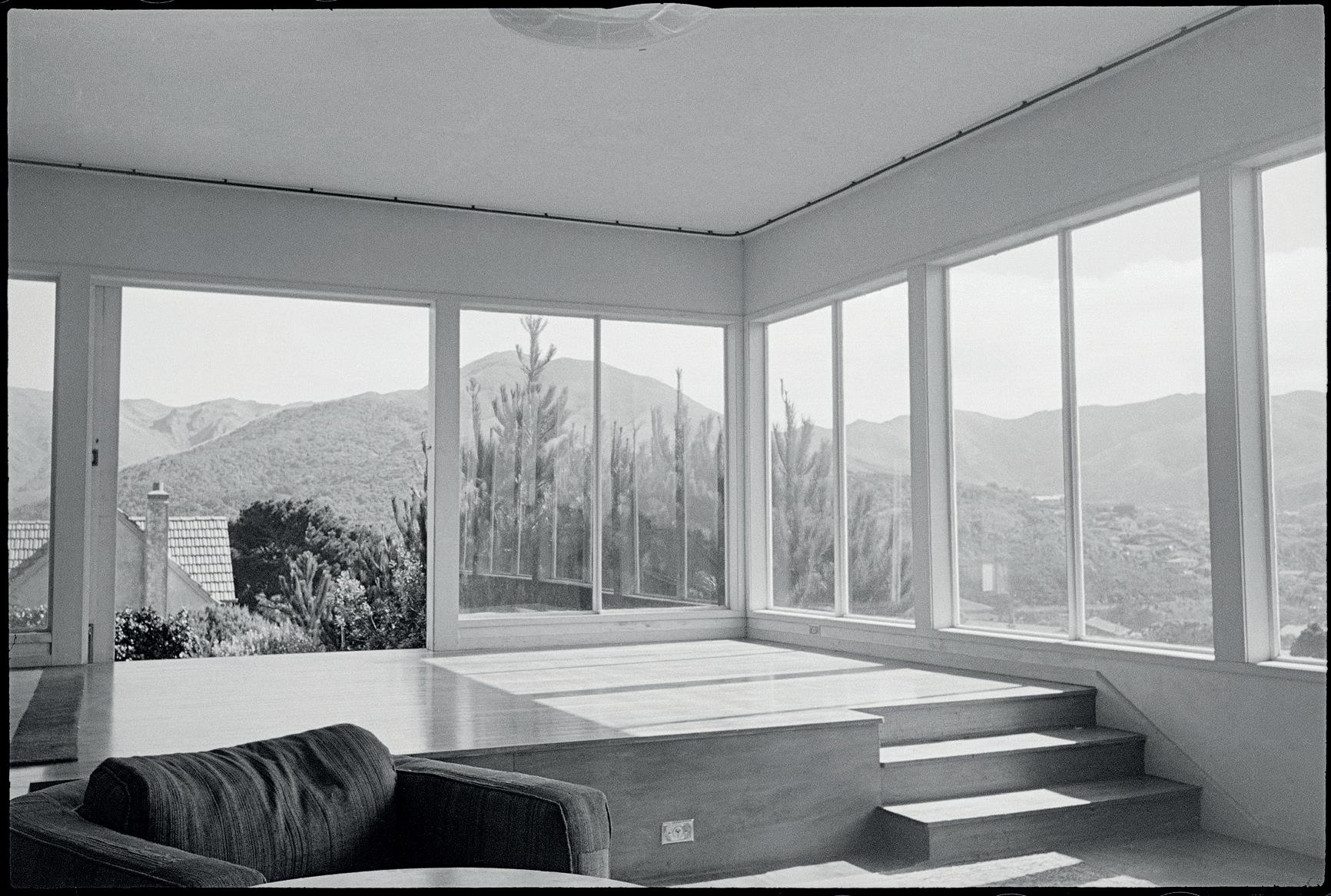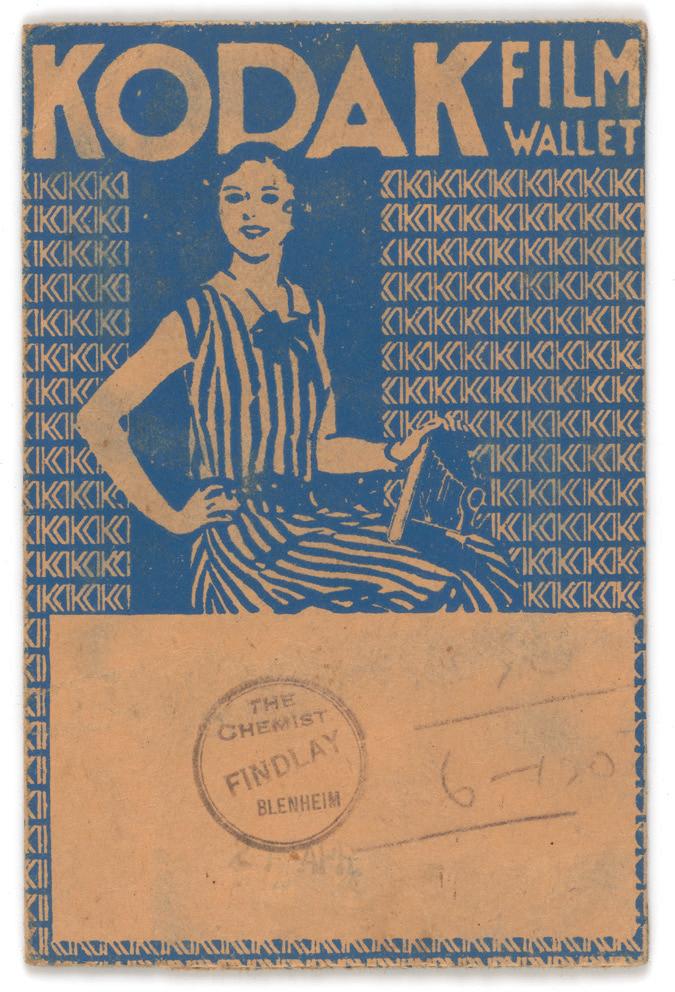
14 minute read
INTRODUCTION
ON 16 APRIL 1883 a most unusual case came before the magistrate sitting at the court in Naseby, in Central Otago. Fifty-seven-year-old Marion White, who had been a domestic servant in her native Scotland and was now married to a goldminer, had travelled to the settlement some weeks before to have her portrait taken by photographer Malcolm Ries, who ran the only photographic studio in town. She did not like the proofs she was shown, and when she told him so a flaming argument began that spilled out into the street. The constable was called and Ries was charged with using indecent language.
On the day of the hearing Ries conducted his own defence, during which he mocked White for expecting him to show her as a much younger woman: ‘I can’t make a young girl of you,’ he said. Ries was found guilty as charged and fined.1
Given this unpleasant experience, it is easy to see the appeal that a woman photographer might have had for Marion White, and had she been living elsewhere she may well have been able to find one. It is not certain why White found her way to Malcolm Ries’s studio in 1883. Perhaps, having worked hard to establish a new life here, she wanted to send her portrait back to her relatives in Scotland as proof of her success. She expected Ries to show her as she saw herself, but, in an era when, unless you were wealthy and had been taught the complexities of operating the glass plate negative process, and when only professionals owned cameras, he held the power. As the decades passed, however, women would come into their own in photography in Aotearoa New Zealand, both as makers and as subjects.
This book shines a light on those women, and in the process recovers the identities and stories of women who have been hidden from history. Its deliberate focus is on individuals, not to argue for them as exceptional but rather to combat anonymity and generalisations, particularly in the case of working-class women.2
Along the way, the book reveals less explored areas of New Zealand photographic history, including portraiture, photographic factory and studio workers, and amateur photography. It delves into photographic genres such as home portraiture, family photography, album making and photojournalism,
Opposite. Eva Cooper (right) and her sister Irene Ashwood photographed on the porch of their parent’s house at 83 Stanley Street, Berhampore, Wellington some time between 1923 and 1926. Eva has put her own Kodak Brownie camera down on the porch while the photograph is taken. William Saunderson Cooper. Sheet film negative. Gift of Andrew Cooper, 2001. Museum of New Zealand Te Papa Tongarewa (A.017915).
This page, right. Hand-coloured portrait of Fletcher Johnston, about 1890. Wrigglesworth & Binns, Wellington. Albumen silver cabinet card print. Alexander Turnbull Library, Henrietta Charlotte Johnston Collection (PA1-o-1890).
Below left. Wedding portrait of a couple whose jewellery (including the woman’s wedding ring) and their cheeks have been handcoloured, 1875–80. Clifford and Morris and Co., Dunedin. Albumen silver carte-de-visite print. Gift of Simon Knight, 2015. Museum of New Zealand Te Papa Tongarewa (O.043328).

Below right. An unknown colourist has taken detailed care with the miniature painting of a floral arrangement and headdress in this portrait of Kate Alderson, about 1873. Clarke Brothers, Auckland. Albumen silver carte-de-visite print. Purchased 2022. Museum of New Zealand Te Papa Tongarewa (O.049521).

Right. Hand-coloured portrait of John Douglas, 1870s. London Portrait Rooms, Dunedin. Albumen silver cartede-visite print. Gift of Wilga Pierson, 1971. Alexander Turnbull Library (PA2-1042).
Left. Louise Laurent (second from left, standing) with fellow Elam School of Fine Arts students, holding paint brushes and palettes. Back, from left: unidentified, Laurent, Margaret Woodward (later Jackson), Jane Eyre, Alice Falwell (later Whyte), unidentified. Front, from left: Edward Payton, Amy Rhodes (later Smythe), unidentified, about 1897. JC Morton, Auckland. Copy print. Hocken Collections Uare Taoka o Hākena, University of Otago (S18-155c).

Below. Women colouring photographs in the workroom at Christopher Bede Studios Ltd, Auckland, 1949–50. Frank Hofmann. Sheet film negative. Gift of the Frank Hofmann Estate, 2016. Museum of New Zealand Te Papa Tongarewa (B.078576).

Nevill Studio was operated by sisters Joyce and Joan Nevill, who first employed Wardrop in about 1946, when she was a sixteen-year-old school leaver. When the studio, under the same name, was taken over by PS Anderson, Wardrop continued “to work there, and then from home after her marriage in 1948. Her work included portraits of her own children (see page 31). Sahar recalls her mother’s ‘little bottles of linseed oil, the special smell, and feeling proud of her and somewhat in awe’.46
Unlike the process of adding colour to black-and-white photographs, which has an obvious and enduring charm, the process of retouching by hand has been largely forgotten (though it continues in digital form). Yet retouchers were vital to the success of portrait photography businesses. In her important history of the first century of photography, published in 1939, photographer Lucia Moholy explained that retouching was the way to increase the effects of composition in a photograph – ‘to strengthen or weaken lights and shades, to remove wrinkles and other details, and – if desirable – to alter the shapes and figures of the persons in the picture’.47 What started as a decorative extra had, by the late nineteenth century, become a necessity since larger photographs meant that more imperfections were visible in portraits.
Retouching the negative involved drawing onto the photographic emulsion containing the image with a lead pencil in a circular motion called a ‘stipple’ effect. This was best done without lifting the pencil off the negative and had the effect of blocking out the intensity of the darker areas. The task required ‘a technical knowledge of anatomy and art, as well as skill in using a retouching pencil’,48 to create well-blended tones and an effect that was not visible when the negative was printed. A special portable folding stand was developed (see page 348) that enabled retouchers to work more comfortably than at a flat desk and without resting their hands and arms on their work and causing damage and discoloration.
The influential British photographer Dorothy Wilding considered retouching a highly skilled job and ‘imperfect retouching the badge of the bad photographer’. The process was not intended just to make people look ‘more beautiful or handsome . . . than in real life’ but rather, by the twentieth century, to correct the effect of the very strong light required to catch the subject without movement. Hence the negative exaggerated all the lines, folds and creases in the face, which could be ‘quite grotesque’. To make a portrait ‘as the lens of my eye saw it, and not the lens of the camera’ required the skilled retouching of the negative. Wilding did comment, however, that showing the ‘very bitter pill’ of an untouched negative was a good way of getting rid of a ‘tiresome client’.49
By the 1890s, when more people were taking, developing and printing their own photographs using the new Kodak equipment aimed at the domestic market, the skills of the retoucher were a way for studios to set themselves apart and assert their superior skills. Louise Laurent, great-aunt of Auckland artist Stella Brennan, attended the Elam School of Fine Arts in 1896 and 1897, and used her training to earn a living as a retoucher.50 Laurent was born in France and arrived in Aotearoa as a child with her single working-class mother. Art school was a pathway into the potentially interesting and respectable vocation of retouching, which used knowledge of anatomy and drawing skills.




Opposite above, left and right. Mill Bay, Whangaroa and Carved Maori House. Katarina Hansard, Kaikohe, date unknown. Below right. Portrait of Katarina Hansard by an unknown photographer. All published in the Auckland County Districts (Section 3) Free Part of the Cyclopedia of New Zealand, 1897–1900. Photomechanical halftone prints. Auckland War Memorial Museum Tāmaki Paenga Hira (AE91-CYC-p58-2, AE91-CYC-p53-3, AE91CYC-p53-4).
Opposite below left. Photo of a hand-coloured portrait of Aneta Hansard, thought to have been taken by her mother, Katarina Hansard, and lost in the fire that destroyed the Tūtānekai wharenui, Ōwhata Marae, Rotorua, in 2003. Hiwinui Heke, 1999. 35mm colour copy photograph. Private collection.
Right. Little girl with doll, 1893–98. Katarina Hansard for GA Hansard Studio, Kaikohe. Gelatin silver cabinet card print. Auckland Libraries Heritage Collections (1192-46).
AN INCREASING NUMBER OF women were working in photography studios during the 1890s, partly as the result of the skills they had learnt through their work, but also because photography could offer financial and personal autonomy. Now, however, more young single women were also setting up their own studios, with varying degrees of success.
When Agnes Williamson arrived in Westport from London in 1896, prospects seemed bright. She had with her the substantial sum of £500, a gift from an aunt in England; half was hers and the other half was for her sister, Isabella, in Reefton.115 Isabella and her husband, Peter McHugh, had promised to help pay Williamson’s fare if she brought them their share. When Williamson moved into their home in Reefton, she soon became aware of her brother-in-law’s mounting debts, even as she was setting about opening a photography studio in the town, taking portraits in her studio and photographing local events and happenings.
Williamson was soon working hard and had a thriving business, with her studio’s address printed as ‘Lower Broadway’ on her portrait mounts.116 In 1902 her panorama of the aftermath of a fire at the Southern Quartz mine at Reefton was published in the Auckland Weekly News. 117 A small number of her portrait photographs survive and show the elaborate backdrops she painted for the sets in her studio.
Above and opposite. Dredge construction, West Coast, 1896–1907. Agnes Williamson, Reefton. Gelatin silver prints. Blacks Point Museum, Reefton.

Trouble struck when Peter McHugh, who was the manager of a timber yard, was declared bankrupt in July 1907. Williamson testified in court that she had lent him her share of the money from her aunt along with ‘her wages at the rate of 15s per week, and her earnings as a photographer and painter’, presumably out of a sense of loyalty or obligation. Her receipts showed her earnings amounted to £600, £150 of which was costs for materials. When she asked him to repay her, McHugh transferred property in his name to her and Isabella,118 which rendered them liable for his debts. In early September the court ordered that the property, including household chattels and ‘photographic stock’ owned by the two sisters, be sold by public auction.119
Williamson arrived in Wellington on 21 September with the intention of living there but was arrested a few days later, after the Reefton police telegraphed a warrant, on the grounds that she was intending to leave the country and evade

Opposite. Basaltic Columns, Owenga, C.I. Right. At Owenga, C.I., 1890s.
Constance Foster, Rēkohu Chatham Islands. Gelatin silver prints. Gift of Victoria University of Wellington, 1964. Museum of New Zealand Te Papa Tongarewa (O.006977, O.006972).



In 1945 Verry, a British-born subject who was therefore exempt from the regulations that constrained his wife, applied to have Koppel’s Leica returned to him so that she could take photographs of their two young children, especially following the birth of their son.94 The request was declined, but Koppel was allowed to collect the camera for periods of two to three days to ‘be used exclusively in photographing members of her own family’, and only in her own home. Thereafter she was to return the camera to the police.95 This arrangement remained in place until 19 November 1945, after the end of the war, when Koppel’s registration as an alien was cancelled.
Koppel’s highly regarded architectural photographs, often featuring the buildings of émigré architects, continued to be published until the mid-1950s in such Modernist publications such as Home and Building and the New Zealand Design Review. Her photographs of houses by Plischke and Charles Fearnley appeared on the covers of the latter in 1950.96 Koppel also continued to take portraits on commission until the early 1960s. However, her thirty-year career as a photographer in Aotearoa was marred by displacement and lack of recognition.
In 2001, art historian Leonard Bell expressed surprise that, ‘given the high quality of much of her work and the genres in which she worked – portraiture, photo-journalism, and architectural photography’, she had been forgotten and not included in any histories or accounts of photography in Aotearoa, but instead had ‘dropped out of sight’.97
The genres Bell identified are precisely those that have been marginalised in the histories of photography in Aotearoa. They are also the genres in which most women involved in the medium worked. It was in these genres, too, that Modernism and ‘New’ photography first appeared in Aotearoa in the 1930s, thanks to photographers such as Eila Bristow and Elsa Mawley, who trained overseas, and refugee photographers such as Irene Koppel, who came here from Europe.
Opposite. The Kahn house in Ngaio, Wellington, designed by architect Ernst Plischke and built in 1941, 1941. Irene Koppel, Wellington. 35 mm film negatives. Alexander Turnbull Library (35mm-35607-5-F, 35mm-35602-14-F).
Such freedom was denied Easterbrook-Smith, who was confined to the studio. When, in 1942, the police came to the studio to check what work Easterbrook-Smith was doing, Deste declared that her studio did no work of a military nature and that she knew Easterbrook-Smith’s camera equipment had been confiscated and that she was not allowed to do any camera work.110
Because Easterbrook-Smith had to pay for childcare while she worked doing processing in Deste’s darkroom, the financial return was ‘scarcely worthwhile’.111 She applied to have her camera equipment returned on the grounds of financial hardship, but once again the request was denied,112 even though she was married to a New Zealand citizen. The Easterbrook-Smiths considered Irene Koppel’s ability to work outdoors in the city ‘an unfair anomaly’ and complained to the commissioner of police, but nothing changed apart from Koppel’s permit then being cancelled.113
In an interview in 1984, Easterbrook-Smith put the ‘unpleasant treatment’ she received during the war down to ‘small-town attitudes’.114 Because of what had happened to her in Blenheim, she suffered more restrictions and surveillance than Irene Koppel and fellow Jewish refugee Richard Sharell, who was allowed to keep his camera for ‘continuing his work as a photographic artist’ until 1942.115
Right. Hand-coloured view of the New Zealand Centennial Exhibition tower, 1939–40. Eileen Deste Studio, Wellington. Gelatin silver print. Purchased 1999 with New Zealand Lottery Grants Board funds. Museum of New Zealand Te Papa Tongarewa (O.020401).
Opposite. Helen Adair McMaster at the piano, about 1900.
Right above. Child, probably Helen Adair McMaster, about 1897.
Right below. Child, probably Helen Adair McMaster, about 1899.


Below. Kniphofia (red hot pokers or torch lily) in a vase, about 1900.
Agnes Jane Reid or Florence (Nellie) Reid, Elderslie Estate, North Otago. Gelatin dry plate glass negatives, Waitaki Archive (101557, 101577, 101575, 101727).

AMATEUR FAMILY photography can be a dynamic documentary form. It can expand how images are made through multiple authorship, collaboration with the subjects being photographed and as a generator of social ties. Although a family collection of photographs may appear to be primarily the work of one person, close study often shows that other members also made images. Two such examples exist in the photography collection at the Museum of New Zealand Te Papa Tongarewa. In the first, Eva Cooper is revealed to be the photographer of numerous images in the personal archive of her husband, William Saunderson Cooper, who was the government’s resident agent on Mauke Island in the Cook Islands from 1913 to 1921. One pair of family portraits, taken on a summer picnic in 1917, shows the three Cooper children with each parent – the other taking their turn behind the camera in each case (see page 222). And the children were also taking photographs: in another family portrait, one son holds what is presumably his own camera.
Several photographs of Eva show her with a camera. A portrait of one of the couple’s teenage sons, taken at Eva’s parents’ house in Berhampore, Wellington, includes the shadow of a woman photographer – an indisputable sign of authorship (see page 223). Because Eva died long before her husband, who remarried, perceptions of her authorship of the photographs have been buried and complicated.
The Kingsford family album from the early twentieth century documents and celebrates the first three years in the life of Peter Kingsford, who was born in Nelson in 1920 (see left). It was made by, and also features, Peter’s parents, Charlotte and Reginald. The strongest photographs show the care of baby Peter and day-to-day life in the household with an infant – washing, naps, walks with the pram. The handwritten captions on many of the album pages are both descriptive and affectionately humorous: ‘Fatty’ (Charlotte and a chubby baby Peter) and ‘In Dad’s Flying Cap’ (Reginald, who had a distinguished military career as a pilot in the Royal Flying Corps in the First World War, in military uniform holding Peter, who wears his cap). Peter died, aged twenty-two, when his aircraft exploded in the air over Egypt during the Second World War.
Above. Two’s Company, published in Photograms of the Year 1939, Iliffe and Sons, London, 1940. Thelma Kent. Photomechanical halftone print. Museum of New Zealand Te Papa Tongarewa (tam.11515).Opposite. The Hooded Terror, near Pūponga, Cape Farewell (with Naare Hooper), about 1938. Thelma Kent, Christchurch. Gelatin silver print. Alexander Turnbull Library (PAColl-3052-17).

Field Camera
A sub-category of the view camera, this was popular for scenic and landscape photographs in the nineteenth century and held glass plate negatives – 10 × 8 inches in size – which printed at the same size as the negative.
Film Wallet
A paper folder given to customers by photographic suppliers with their processed negatives and prints inside.

Finisher
In analogue photography, a person or firm that develops and prints photographs.
Flash Bulb
A glass bulb, like a small lightbulb, that is usually synchronised with a camera’s lens and releases a burst of light onto a scene as the photograph is being taken.
Flash Powder
Replaced by the flash bulb, flash powder was placed in a tray and ignited, causing an explosive light and sound.
Folding Camera
A sub-category of the view camera, this portable and compact camera, which closed inward into a rectangular box shape that enfolded the lens and bellows, dominated camera design from the 1890s to through the 1930s. Despite its size, especially when closed, it used large 4 × 5 inch negatives.

GELATIN GLASS PLATE NEGATIVE/DRY PLATE NEGATIVE
These negatives made wet plate collodion negatives redundant because they did not have to be exposed while still fresh from wet chemicals. The negative consisted of silver salts (reduced simply to silver after processing) in a layer of gelatin and coated onto a sheet of glass. Factory-manufactured from the early 1880s, these negatives were used in some cases until the 1930s, due to their familiarity and ability to remain flat and produce sharp images.
Gelatin Silver Print
The most common type of black-and-white photograph before digital photography, first developed in the 1880s as a printing out process (see page 345). The gelatin silver print consists of a layer of gelatin containing grains of silver coated onto a sheet of paper. By the early twentieth century gelatin silver prints had evolved into a developing out process (DOP) paper that was exposed to the image from the photographic negative and developed in a darkroom under controlled light.
HANDBOOKS/MANUALS

Many New Zealand photographers learnt photography by reading handboooks that described the process and equipment and how to use it. Titles commonly distributed in New Zealand included the monthly PhotoMiniature series (1899–1932), from New York publisher Tennant & Ward and Kodak’s own monthly journal Australasian Photo-Review, which was published between 1895 and 1956. Kodak also produced how-to publications aimed at the home portrait maker and amateur such as its 1924 booklet At Home with the Kodak.
Opposite below. Kodak model 3-A folding camera, 1911. Gift of Mrs Ramona Webb, 1990. Museum of New Zealand Te Papa Tongarewa (TP000099). Opposite above. Kodak Girl film wallet, 1930s. Museum of New Zealand Te Papa Tongarewa (PE.000169). Above left. A selection of handbooks. Private collection. Above right. Advertisement for Harringtons’ Willis Street store in the Harringtons Catalogue, 1914. Wellington. Private collection.
HARRINGTON’S NEW ZEALAND LTD
A branch of the Australasian photographic supply firm, which had premises in Queen Street, Auckland and Willis Street in Wellington, and sold cameras and other photographic equipment. When a camera was purchased, they provided free photographic instruction sessions either in person or via mail, developed negatives, and processed and printed photographs for those who did not want to do it themselves. Harrington’s also offered an enlargement and colouring services via contract photographic workers and had its own product catalogue.






